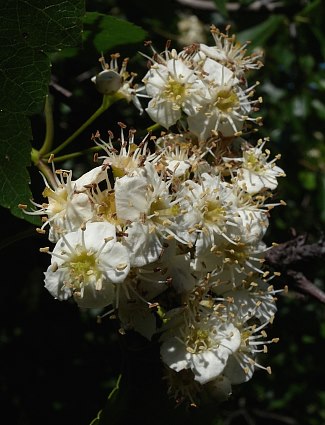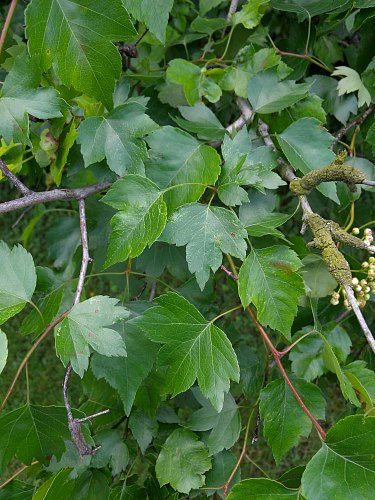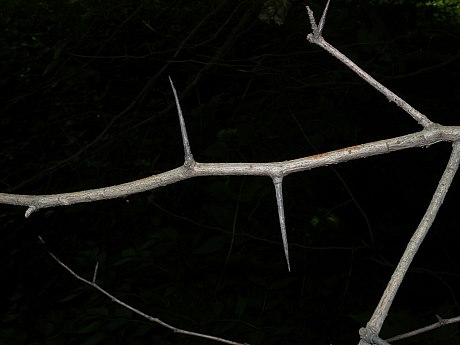Description: This is a shrub or small tree up to 25' tall and 20' across. It has single or multiple trunks at the base and a densely branched ovoid to globoid crown. The outer trunk bark is more or less gray, falling off in flakes to reveal an orange to orange-red inner bark; it is also somewhat rough and scaly. The bark of most branches is light gray and more smooth, while young twigs and shoots are light green, red, or brown. The latter are also smooth, hairless, and variably thorny. Mature thorns are 1¼–2¼" long, straight, and gray. The alternate leaves are up to 2½" long and 2½" across, broadly ovate or deltate-ovate in outline, and often sharply divided (cleft) into 3 major lobes. When such lobes occur, the terminal lobe is as large or larger than the 2 basal lobes. The leaf margins are shallowly cleft and coarsely toothed. The upper leaf surface is medium to dark green and glabrous, while the lower surface is a more pale shade of green and glabrous. The lateral veins of the leaves extend to both the tips and sinuses of the lobes. The slender petioles are up to 2" long, light green to red, and hairless to slightly pubescent. Corymbs (flat-headed branching clusters) of flowers about 1½-3" across occur occasionally among the leaves on glabrous peduncles. Individual corymbs have 15-50 flowers and pedicels that are green and glabrous. Individual flowers are 3/8–1/2" (9-12 mm.) across, consisting of 5 white rounded petals, a short green glabrous calyx with 5 teeth, 20 stamens with pale yellow anthers (later becoming brown), and a pistil with 5 small styles. The teeth of the calyx are broadly deltate. The blooming period occurs from late spring to early summer (often the latter) for about 1-2 weeks. The flowers have an unpleasant malodorous scent. Fertile flowers are replaced by small globoid pomes about ¼" (6 mm.) across. The hairless pomes become orange-red to red at maturity; sepal remnants are absent at their tips. Corymbs of mature pomes have a tendency to droop, often persisting into the winter. Individual pomes contain 5 seeds or less; their flesh is rather dry and thin. The deciduous leaves become some shade of red in the fall. The root system is woody and branching.
thorns are 1¼–2¼" long, straight, and gray. The alternate leaves are up to 2½" long and 2½" across, broadly ovate or deltate-ovate in outline, and often sharply divided (cleft) into 3 major lobes. When such lobes occur, the terminal lobe is as large or larger than the 2 basal lobes. The leaf margins are shallowly cleft and coarsely toothed. The upper leaf surface is medium to dark green and glabrous, while the lower surface is a more pale shade of green and glabrous. The lateral veins of the leaves extend to both the tips and sinuses of the lobes. The slender petioles are up to 2" long, light green to red, and hairless to slightly pubescent. Corymbs (flat-headed branching clusters) of flowers about 1½-3" across occur occasionally among the leaves on glabrous peduncles. Individual corymbs have 15-50 flowers and pedicels that are green and glabrous. Individual flowers are 3/8–1/2" (9-12 mm.) across, consisting of 5 white rounded petals, a short green glabrous calyx with 5 teeth, 20 stamens with pale yellow anthers (later becoming brown), and a pistil with 5 small styles. The teeth of the calyx are broadly deltate. The blooming period occurs from late spring to early summer (often the latter) for about 1-2 weeks. The flowers have an unpleasant malodorous scent. Fertile flowers are replaced by small globoid pomes about ¼" (6 mm.) across. The hairless pomes become orange-red to red at maturity; sepal remnants are absent at their tips. Corymbs of mature pomes have a tendency to droop, often persisting into the winter. Individual pomes contain 5 seeds or less; their flesh is rather dry and thin. The deciduous leaves become some shade of red in the fall. The root system is woody and branching.
Cultivation: The preference is full or partial sun and more or less mesic conditions. Washington Hawthorn adapts to many kinds of soil, including those that contain loam, some clay, rocky material, or sand. Sometimes the leaves are disfigured by hawthorn rust and other disease organisms.
Range & Habitat: Washington Hawthorn is native to southern Illinois, where it is occasional (see Distribution Map). Elsewhere in the state, it may occur as an uncommon escape from cultivation. Habitats consist of open woodlands, savannas, woodland borders, thickets, and fence rows. This small tree or shrub is often cultivated as a landscape plant. Like other Crataegus spp. (Hawthorns), Washington Hawthorn is a pioneer species that benefits from occasional disturbance.

Faunal Associations: The malodorous flowers attract primarily bees, flies, beetles and, to a lesser extent, wasps and butterflies. These floral visitors seek nectar and/or pollen. Many insects feed on the foliage, fruit, plant sap, and other parts of hawthorn trees (Crataegus spp.). These insect feeders include the larvae of long-horned beetles, leaf beetles, weevils, larvae of gall flies, plant bugs, the Hawthorn Lace Bug (Corythucha cydoniae), several aphids, leafhoppers, armored scale insects, treehoppers, the Hawthorn Mealybug (Phenacoccus dearnessi), larvae of sawflies, larvae of the Hawthorn Underwing (Catocala crataegi) and many other moths, and larvae of a butterfly, the Striped Hairstreak (Satyrium liparops strigosum). See the Insect Table for a more complete of these insects. Birds feed on the fruits of Washington Hawthorn and other hawthorn trees; this includes the Cedar Waxwing, Northern Cardinal, Fox Sparrow, Northern Mockingbird, Northern Flicker, Hermit Thrush, American Robin, Bobwhite Quail, and Wild Turkey. The Bird Table provides a more complete list of these frugivorous birds. Because this hawthorn and other hawthorn trees are densely branched and thorny, they provide good protective cover and nesting sites for some species of birds. This include such birds as the Blue Jay, Common Grackle, Brown Thrasher, and Willow Flycatcher (DeGraaf, 2002; Homan et al., 1996). Mammals that feed on the fruits include the Gray Fox, American Black Bear, Striped Skunk, and Woodland Vole. The White-tailed Deer feeds on the twigs and fruit, while the Cottontail Rabbit gnaws on the bark of these trees during winter (Martin et al., 1951/1961; Ludewig & Bowyer, 1985; Myers et al., 2004).

Photographic Location: The Arboretum at the University of Illinois in Urbana, Illinois.
Comments: Apparently, the common name derives from an early discovery of this species near Washington, D.C. Of the many Crataegus spp. (Hawthorns) in Illinois, Washington Hawthorn is one of the easier species to identify because of its trilobed leaves. The leaves of other Hawthorns in the state lack the deltate shape and prominent basal lobes. Washington Hawthorn has attractive red fruit during the winter, attractive leaves during both summer and fall, and attractive flowers during the late spring or shortly thereafter. This visual appeal across the seasons is probably the main reason for its popularity as a landscape plant. The availability of thornless cultivars further enhances this popularity.